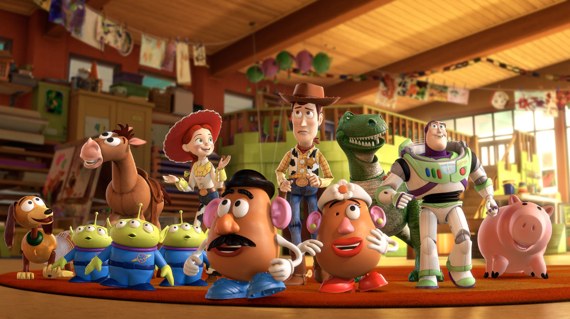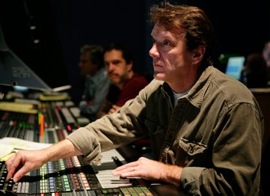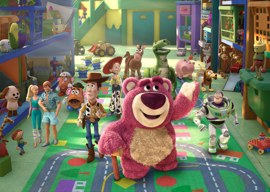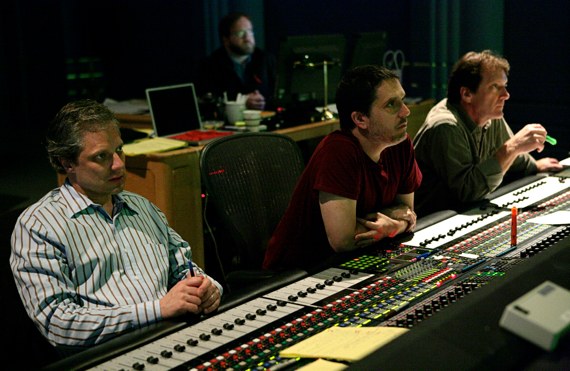
Thanks go out to Tom Myers, Michael Semanick, and Al Nelson from TOY STORY 3 for taking time out to answer few questions about their work on the film!
TM = Sound Designer/ Sound Re-Recording Mixer Tom Myers
MS = Sound Re-Recording Mixer Michael Semanick
AL = Sound Editor Al Nelson
JAKE: “Day & Night” the short film that played before “Toy Story 3” was so creative in the way it used sound. Were there discussions early on about how sound design would drive the story? Pixar has a rich tradition of selecting short film ideas from fellow Pixar employees’ pitches. Who does sound for these short films at Skywalker?
TM: The sound duties for Pixar’s shorts are split between Skywalker and Pixar. For some of the earlier shorts, we did all the work at Skywalker, but over the last few years Pixar has developed a small staff of very talented sound folk. On “Day and Night” the sound design was done by Barney Jones at Pixar with guidance from Sound God Gary Rydstrom who splits time between the two companies. I did the mix here at Skywalker with the director Teddy Newton and Barney present.
MIGUEL: When did you guys start on “Toy Story 3”? How did Lee Unkrich interact with the sound department and what was his take on how sound would be utilized in the film?
TM: We saw a storyboarded version of the film in early 2009 and then had preliminary spotting sessions with Lee and composer Randy Newman. I started sound design in late 2009 and the rest of the crew started in January of 2010. Lee was very involved in the process and knew the library very well having been the editor on the first film and codirector on the second. He is very detail oriented, even spending time with the foley crew. His first concern sound-wise was that we make the third film a continuation of the world created in the first two. All three films needed to feel organically part of the same aural universe, just as they were visually.
AN: I came on the show for the first temp mix in the fall of ’09. This was a great broad stroke introduction to how Lee intended the film to sound. We walked away with some great notes to think about for the final, though, I didn’t actually start cutting effects on the film until late February. So, I’d like to acknowledge Dustin Cawood, Terry Eckton and Tim Nielsen who fortunately did all the hard work before I jumped in.
 JAKE: How much sound did the animators request before you guys started sound editorial in earnest?
JAKE: How much sound did the animators request before you guys started sound editorial in earnest?
TM: The animators had much of the toy movement sound library from Toy Story 1 and 2 for the returning characters, Buzz, Woody, the Potato Heads, etc. The only new character for which they really asked new material was Big Baby. We gave them a larger palette of vocals for Big Baby that Lee was quite particular about.
MIGUEL: Given the toys’ size in relation to the human world, how important was the sound POV of our heroes? What realistic sounds had to be embellished to convey their size or perspective?
TM: With Gary Rydstrom we continued the conceit that when the toys are interacting with humans, (when they are inanimate objects), they should sound smaller in scale compared to the human “real” world. But when they are interacting with each other, and walking and talking, they have a larger, almost human scale to their sounds. We always embellished sound when a threat was implied, especially in the finale scenes with the garbage truck, bulldozers, conveyor belt, shredder, claw, etc.
AL: We had creative license during certain toy POV scenes to even go over the top a bit. For example when Big Baby is doing that creepy march towards Woody, Bullseye and the aliens, we added low end sweeteners to his footsteps. We also added some rumble and actual diesel truck sounds to some of the RC trucks patrolling to add a sense of tension and danger.
JAKE: Did sounds for reoccurring characters established in the first two films carry over to “Toy Story 3”? Were they cut from libraries built for the first two films and or what new sounds, were recorded or expanded on for these classic characters?
TM: We used all the sounds from the first two movies for the recurring characters. This was part of our mandate from Lee about making all three films an extension of the same world. We developed new material for Buzz when he went through his transformations, first to what we called “Militaristic Buzz”, (when Buzz gets reset and does the bidding of Lotso); Here we sharpened his movements making them more precise, more clipped and less rattley toy plastic . And then for Buzz in “spanish mode” we made him more fluid and romantic adding swishes, castanets and whip cracks.
MS: An interesting problem came up with voice futz’s from the original films to this one. Both Woody and Buzz have sayings or dialog built into them when a child pulls Woody’s chord or pushes Buzz’s buttons. These original futzes were done by Gary Summers. He used what we call a analog futz box. It is an inclosed box, with a set of speakers in them and a microphone. You route the dialog to this box , pick the speaker you want the dialog to come out of (might be an old am radio speaker, a telephone speaker, or a speaker taken out of an old toy) the microphone picks up the sound coming out of the speaker and comes back to the console to be mixed. Well, back on TS 1 AND TS 2 , They only futzed what they needed to, with no addtional lines. TS 3 Had new Woody and Buzz lines. Lee wanted the same effect or futz from the other films… no problem, right? Theoretically, we just pull out the old futz box and do it. Unfortunately, that old futz box had been thrown away. We tried every protools plug in, but we could not match the futz. Howie Hammerman, an engineer at skywalker who built the orginal futz box, is still working there. I asked him to rebuild it. With the new futz box and some tweaking we were able to match the futz’s very, very close, though still slightly different. I would say about-ten-years-or-so-of-wear -and-tear-from-Andy-playing-with-the-toys difference. Ha!
AN: Tom was very thorough about providing us with notes and references to the previous Toy Story films as well as providing us with new material that was consistent. For example, Ken’s neck and arm squeaks which complimented Barbie’s elements from TS2. I think those Ken squeaks are some of the funniest moments in the whole movie. Gary would also come in and review our material. He could recall verbatim sounds he had made ten years ago. Also, kudos to our foley artists, Jana and Dennie who performed many of the signature sounds for the original Toy Story and Toy Story 2.

MIGUEL: How did you distinguish what toy sounds needed to be foley and what would be recorded and cut as effects? Did you start with using the actual toys for their sounds? What toy sounds are designed using sounds that the actual toys don’t or can’t make?
TM: Generally, all the footsteps for all the characters were foley. The movement for all the characters may have been half foley and half effects. Specific character trait sounds like the Potato Head pops and hits, Rex chicken squawk head turns, and Barbie and Ken squeaks were effects. We don’t always start with the actual toys as often times they sound too small. We look for something that is slightly larger in scale. For example, of Stretch the Octopus we used a rubber bath mat with suctions cups on one side.
JAKE: How did the tradition of using Skywalker sounds from previous films (Rex’s “Jurassic Park” roar) in Pixar films come to pass? Does Pixar request using these specific sounds in their films during their spotting sessions?
TM: It has more to do with what is dramatically correct for a given scene rather then paying homage to a given sound or film. They will use other films as a reference but rarely request a specific sound, unless it is something they have used in the guide track and it works perfectly, both dramatically and emotionally.

MIGUEL: I love the playful relationship between music and effects in these films, especially when music seemingly acts as Foley for on-screen action (like classic Disney cartoons). How was featuring music or effects for specific sequences decided on?
TM: This all came from Lee and his work with Randy Newman and with us. One example was the scene of Woody’s first escape from Sunnyside when he flies over the wall on the kite and then gets blown up into the sky, the kite breaks and he falls down into the tree where Bonnie finds him. Lee specifically asked for Randy to give that scene the “Carl Stallings treatment” in which he hits all the movements with musical beats and the we support it with sound effects.
MS : Lee was always the one making these final choices. We would experiment from time to time, like: “Try dipping music here”, or “Shift it slightly so that some of the sound effects can live with it” or “Lets clean out all sounds and only add what we need”. The music was very fun to mix; it had a real throwback vibe to it, like you said, very “playful”, playing the action. Lee and Randy had designed it to be that way. I think it fits the film perfectly. It did make it hard at times for sound fx and music to live together, but Lee was very clear and decisive about what was to drive the scene. One of my favorites is the music when Woody gets up in Bonnie’s bed and walks across it. It’s just great. Listen to the arrangement and watch Woodys fingers.
AN: Lee was very specific about how certain sounds felt rhythmically relative to the music. Ambient elements like the crows during Chuckle’s flashback as well as specific hard effects like that last horn honk as Ken and Barbie arrive during the credit roll were all placed in time according to how Lee felt they would sit against the music.
JAKE: With all dialog for the film recorded on a ADR stage, how much of it has to be “placed” in the scenes with reverb and/ or delay? What other creative ways are you able to use dialog when it’s as controlled and clean as it is in an animated film?
TM: Michael can speak more directly to this but every scene and locale had a specific treatment of reverb, e.g., inside the toy box, in the garbage bag, inside the box and outside the box. One of the trickiest scenes was inside the candy machine. The voice treatment had to evolve as Buzz got closer. Lee was keen on all this and playing all perspectives. Also, as all the dialog is clean there is a tradition of panning all dialog in Pixar’s movies.
MS: Every scene had to have a specific treatment on it to fit the scene. It was mostly reverbs. I love the Lexicon 960, so I used it the most. I also used the tc6000 as well as the Lexicon 480. When Dialog is as controlled and clean as in ADR, it does allow you, at times, to get very quiet. When you do not have heavy background noise to fight through, (as you sometimes do with production dialog) it helps the music and sound effects give depth to the film. One of the fun moments of dialog effects, is when Mrs. Potato head sees with her other eye. I had to reach back to my days in the recording studio. I took her dialog, made a copy, advanced it several frames, put it in reverb, recorded only the reverb return, took that and reversed it or played it backwards, like taking analog tape and flipping it upside down and playing it. This effect proceeds her actual dialog slightly, so it had a type of “ghosting” sound. I then added a couple delays and reverb to her original dialog to help fill the room and surround the audience, and the sound effects from Tom helped the dialog sit in there. I think we got a fun “time warp” feel.

MIGUEL: How does the new dolby 7.1 standard allow you to do in the mix that 5.1 didn’t? Is this new channel layout addressed from predubs to printmaster?
TM: It allows you to be more precise in placing things in the acoustic space, pulling things, music, backrounds and effects off the screen and into the room which has the added benefit of clearing up dialog on the screen. We premixed all the effects in the 7.1 format and carried it all the way through to printmaster.
JAKE: Since filmmakers may change a cut to allow some breathing room after a big laugh in a comedic film, was there any attention paid to the potential of sniffles from the audience mucking up your mix during some of the movie’s sadder scenes?
TM: We were very clear where the big emotional moments were and worked hard, mostly through a process of elimination to not undermine or cut short any of these spots. The same goes for the jokes, though those are more precise and rhythm dependent where as the emotional moments are longer and more fluid. It’s a tribute to Lee and the story that there are so many of both kinds of spots in the film. I think of the film as being so funny but much of the feedback I get is of the emotional wallop the film has at the end.
Great interview. I reaaaaally hope 7.1 theatrical is a success, it’s a great push forward. I feel like 7.1 is the true sweet spot for surround sound, and I can’t wait to get more true discrete 7.1 tracks for home.
It is very strick for the people but we must be aware of our family he doesnt burn it a lot.
Just saw the movie yesterday. The sound work is really details, small sound that make the difference.
Loved the little aliens squicks… :)
Really cool to read that, I thought the sound in Toy Story was brilliant. The whole movie was, day and night was amazing as well
The movie is full of sound effects and references to other movies. There are sound effects from Star Wars, Jurasic Park, Pirates of the Carrabian, and more. There are recreated scenes from those movies too. I don’t know why they try to hide that fact when asked.